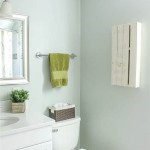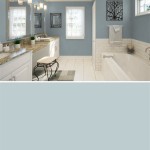Best Type Of Paint For Bathrooms
The bathroom is a high-traffic, often-humid space that requires special consideration when it comes to choosing the right paint. Not all paints are created equal, and some are better equipped to withstand the unique challenges of a bathroom environment. Opting for the wrong paint can lead to issues like peeling, mildew growth, and discoloration. This article will guide you through choosing the best type of paint for your bathroom, highlighting the key factors to consider and the top paint types suitable for this space.
Key Factors to Consider When Choosing Bathroom Paint
Before diving into specific paint types, it's essential to understand the critical factors that influence paint choice for bathrooms. These factors will help you narrow down your options and make an informed decision:
1. Moisture Resistance
Bathrooms are naturally prone to moisture, with steam from showers and baths creating a humid environment. This moisture, if not properly addressed, can lead to paint damage, mildew growth, and even structural issues. Therefore, moisture resistance should be a top priority when selecting bathroom paint. Look for paints specifically designed for high-moisture areas, such as those labeled as "bathroom paint," "shower paint," or "tub and tile paint." These paints typically incorporate ingredients that create a moisture-resistant barrier, preventing water damage and promoting longevity.
2. Mold and Mildew Resistance
Moisture naturally invites mold and mildew growth, which can quickly become an unsightly and potentially hazardous issue in bathrooms. Choosing a paint with mold and mildew resistance is crucial to prevent these microorganisms from taking hold. Look for paints with anti-fungal or anti-microbial additives, as these components inhibit the growth of mold and mildew, keeping your bathroom looking fresh and clean.
3. Durability
Bathrooms are often subjected to frequent cleaning and scrubbing, making durability an important factor for bathroom paint. Choose a paint with good scrubbability, as this will allow you to easily remove stains and maintain the appearance of your bathroom walls. Look for paints labeled as "scrubbable" or "washable," indicating their ability to withstand repeated cleaning without chipping or peeling.
4. Finish
The finish of your paint can significantly impact the overall appearance and functionality of your bathroom. Glossy finishes are known for their high shine and ability to reflect light, making them ideal for smaller bathrooms where you want to create a sense of space. However, glossy finishes show imperfections more easily and can be more difficult to clean. Matte finishes, on the other hand, offer a more muted appearance, hiding imperfections better and providing a softer, more elegant look. However, matte finishes are more susceptible to staining, making them less ideal for high-traffic, high-moisture areas.
Top Paint Types For Bathrooms
With the key factors in mind, let's explore the most suitable paint types for bathrooms, each offering unique advantages and considerations.
1. Acrylic Latex Paint
Acrylic latex paint is a popular choice for bathrooms due to its versatility, durability, and moisture resistance. It's readily available, comes in a wide range of colors, and dries quickly, making it ideal for DIY projects. Acrylic latex paint is also washable and scrubbable, making it easy to maintain. However, it's important to choose a formula specifically designed for bathrooms, as not all acrylic latex paints are created equal in terms of moisture resistance.
2. Epoxy Paint
For high-moisture areas like shower stalls and tubs, epoxy paint is a robust option. This highly durable and moisture-resistant paint forms a tough, non-porous coating, making it ideal for areas constantly exposed to water. Epoxy paint is also resistant to mildew and mold, further enhancing its suitability for bathrooms. However, epoxy paint can be more challenging to apply, requiring a smooth and clean surface. Additionally, it might not offer the same color versatility as acrylic latex paint.
3. Enamel Paint
Enamel paint, a type of oil-based paint, is known for its high gloss finish and excellent durability. It's also known for its moisture resistance, making it a viable option for bathrooms. However, enamel paint tends to be more toxic than latex paints and requires more time to dry. It's essential to ensure proper ventilation when working with enamel paint.
Conclusion
By understanding the key factors to consider and exploring the top paint types suitable for bathrooms, you can make an informed decision that ensures a beautiful and durable finish for your bathroom. Whether you choose acrylic latex, epoxy, or enamel paint, prioritize moisture resistance, durability, and mold and mildew resistance for a bathroom that stands the test of time.

What Type Of Paint Should I Use In My Bathroom

The Best Paint Colours For Your Bathroom

The Best Type Of Paint For Bathrooms A Full Guide

Bathroom Paint Guide Choosing The Right Finish

Should I Use Flat Paint In A Bathroom Williams Painting

30 Best Bathroom Paint Colors Designers Love In 2024

Ceiling Paint For Bathroom Prestige Painting Gta

The Best Paint Colours For Your Bathroom

Solved Finally Learn The Best Types Of Paints To Use In Bathrooms Wallauer S Paint Center

Bathroom Paint Guide Ideas Advice B Q
See Also







